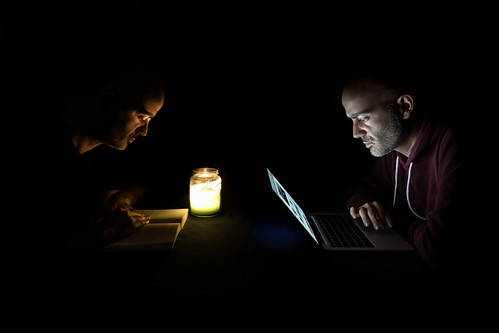
Many of us who work with the use of technology in education get frustrated at the slow uptake of seemingly excellent tools and methods. We see the potential of open networked learning to empower and engage students as well as increasing collaboration, widening participation and fostering creativity and can't understand why our institutions are so slow to acknowledge and absorb these exciting developments.
A common complaint is that whilst so much of society has been changed radically by digital technology, universities look pretty well the same as they did ten/twenty/a hundred years ago (select time scale according to desired shock effect). I confess to having used this argument myself but it's worth taking a few moments to question our rhetoric now and then. Martin Weller does just this in a new post, The hidden tech shift in higher ed, describing how universities actually have changed over the last ten years. The student demographics have changed with many more older students who are studying online, part-time or not living on campus. Technology has actually become ubiquitous though maybe not as much as we would have hoped. Most courses today use learning management systems like Moodle, Blackboard etc and most students use their own devices to access their courses making the old computer labs almost extinct. Administrative procedures are now almost completely digital in many countries and even if the traditional written examination would seem to be the final bastion against digitalisation there are also many examples of digital examination as well as new methods for peer assessment and problem-based learning.
I still believe that there is a suspicion of technology in higher education and a reluctance to experiment but there are also significant structural barriers that we sometimes forget. Weller points to the barrier our classrooms and lecture halls place in the way of pedagogical innovation. Most universities are stuck with legacy architecture.
I think a real problem for higher ed is the legacy of the physical environment for example. We do lectures because we have lecture theatres. More significantly we can’t conceive of doing anything else because the lecture theatres says “do lectures”. It would be very difficult, for instance, to implement a flipped approach in many university courses because the face to face space is built for lecturing and not doing the other things you might want to utilize that time for.
Rebuilding and redesigning our learning spaces is an expensive business and not something that will happen overnight. However many universities are busy doing just that (my own university included) and there are many inspiring examples of new campuses and redesigned buildings that offer flexible, stimulating and technology-friendly learning environments.
Another structural barrier to digitalisation is the fact that teachers are paid for lecture hours in the classroom and when you're provided with lecture halls to meet the students it's no surprise that the lecture still dominates. Time spent on online support and tutoring is often not paid at the same rate as face-to-face lecturing. The administration has simply not adapted to seeing online teaching as being just as valid as classroom teaching and that helps to maintain the status quo. In addition many teachers feel over-stretched in terms of workload and there is simply no time for experimentation and learning new skills. When resources are limited as they often are in higher education there's little margin for experimentation and great pressure to simply effectivise existing activities.
Actually a lot has changed but maybe not as quickly as many of us would wish and maybe not in the right directions. Maybe we also need to realise that the issue of digitalisation is one of many intertwined issues facing education today and that there are no quick fixes. As I have written before it's about evolution not revolution.
No comments:
Post a Comment
Note: Only a member of this blog may post a comment.